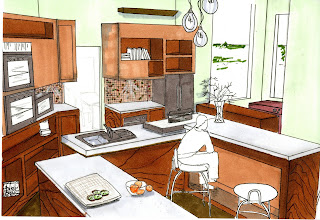"The purpose of architecture is to shelter and enhance man's life on earth and to fulfill his belief in the nobility of his existence " eero saarinen.
Hand rendered with prisma's. Images of the interior spaces of the terminal as well as exteriors.

The JFK memorial terminal, which is located in southeast New York City, New York, is one of the most well known/ recognized architectural structures worldwide. It was not always known as the JFK memorial. It was originally named the Idlewild airport, followed by the Major General Alexander E. Airport, the New York International Airport and finally in 1963 in remembrance of the late president John F. Kennedy they named the airport after him. The very first plane to leave this airport was in 1948 when construction was complete and the terminal was open to the public. The terminal immediately stood out from all other airports at the time because of its innovative design.
This structure is more than an airport because of what it symbolizes. Airports in general are a sign of unity in the literal sense, because they literally bring people together from all over. However this airport has a deeper symbolic meaning that just its obvious meaning. It is in remembrance of a president, and was named after him when he was assassinated. When the leader of a country is suddenly killed or died, followers feel lost, and this tribute stands as a reminder, that we are all united and stand strong. This airport is so much more than your average airport.
A specific moment stands out within this particular design is the TWA Flight Center or Terminal 5. Eero Saarinen, a Finnish American Architect, designed this terminal. This being his most famous piece of work; a blend of all of his previous designs combined as well as his expressionism and skill with concrete being shown. It was designed with the intentions of symbolizing an abstraction of flight. This is what viewers are drawn to when looking at the structure; it captures the eye and draws you in.
This airport was not just visually pleasing but it also contained features never before seen in airports at the time. When terminal 3 opened in 1962. It had a very distinguished and fresh new design. With its large, elliptical roof that suspended 32 seats of radial posts and cables; not only did the terminal cover the terminal but it continued on to the passenger loading area as well. With this particular detail this airport became the first airline terminal that had movable jet ways that connected to terminals.
This structures stands out as being a good example of a well-designed structure because of its importance, how relatable it is to everyone and how it can be appreciated by all. The design of the airports transforms it from its general use, and makes it more of a work of a art.
http://www.nylandmarks.org
http://wapedia.mobi/en/John_F._Kennedy_International_Airport


 [ABOVE] This perspective has the double ovens on the left. The center island is where the main activities of the kitchen take place. The very first part of the island which is closest in this perspective is a lower level than all of the other islands, allowing for Rosie's 4 children to participate in cooking and being involved in the kitchen. The middle section is where the cooking takes place [ stove top and sink] Finally the furthest is an eating area.
[ABOVE] This perspective has the double ovens on the left. The center island is where the main activities of the kitchen take place. The very first part of the island which is closest in this perspective is a lower level than all of the other islands, allowing for Rosie's 4 children to participate in cooking and being involved in the kitchen. The middle section is where the cooking takes place [ stove top and sink] Finally the furthest is an eating area.



































 The JFK memorial terminal, which is located in southeast New York City, New York, is one of the most well known/ recognized architectural structures worldwide. It was not always known as the JFK memorial. It was originally named the Idlewild airport, followed by the Major General Alexander E. Airport, the New York International Airport and finally in 1963 in remembrance of the late president John F. Kennedy they named the airport after him. The very first plane to leave this airport was in 1948 when construction was complete and the terminal was open to the public. The terminal immediately stood out from all other airports at the time because of its innovative design.
The JFK memorial terminal, which is located in southeast New York City, New York, is one of the most well known/ recognized architectural structures worldwide. It was not always known as the JFK memorial. It was originally named the Idlewild airport, followed by the Major General Alexander E. Airport, the New York International Airport and finally in 1963 in remembrance of the late president John F. Kennedy they named the airport after him. The very first plane to leave this airport was in 1948 when construction was complete and the terminal was open to the public. The terminal immediately stood out from all other airports at the time because of its innovative design.



